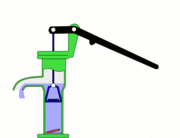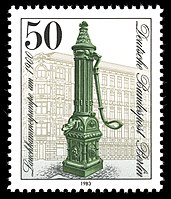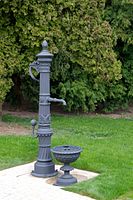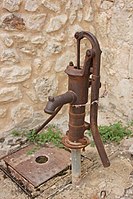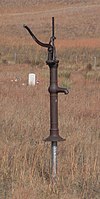Handle pump
A lever pump is a self-priming water pump . Hand pump are simple piston pump , the pistons of a two-arm lever , dick called, is operated by hand. The piston is connected via a piston rod directly connected to the shorter arm of the clapper and usually with a sleeve made of leather sealed.
This pump design is simple and independent of the power grid and water supply . It is used around the world for wells for water supply and often in allotments. Due to its properties, it is used in places for water supply in an emergency if the network fails.
history
Evidence for the existence of this type of construction and functionality is already 300 years old. With this pumping system using the law of levers, those wells were replaced where the water was brought up from an open shaft with the bucket hanging on the rope. With each pull on the rope, the full weight of the water (five to ten kilograms) was pulled directly. Alternatives to this were draw wells that had a swinging boom with a counterweight.
As long as there were no water networks, handle pumps were practical for pumping groundwater and were widely used. Up to the beginning of the 20th century, handle pumps were used for pumping on streets (public street pumps) or as court fountains in front of the house or in the courtyard. Around 1920 handle pumps were still installed in the house in such a way that they were in the kitchen. While aqueducts gained in importance in cities, handle pumps were still widespread in rural areas until well into the 1950s. For certain uses, copies are still available and active.
technology
A handle pump with a well-sealing piston and valves can suck in water from a depth of up to 8 meters; the maximum delivery head is limited by the geodetic suction head , which differs depending on the water temperature and mineral content ( density ) as well as the air pressure (maximum negative pressure <ambient air pressure ).
Construction of a lever pump
- Pump details
Leather cuff and valve
A : open, B : closed, C : view from below
A lever pump operated by hand consists of:
- Pump housing / cylinder
- Handle (lever)
- Piston rod
- piston
- Piston seal (leather sleeve)
- Pump room
- outlet valve
- Water suction pipe
- Inlet valve
- Water leakage
How a lever pump works
The lever pump works as a reciprocating piston pump.
- If you move the handle downwards, the piston is pulled upwards. This creates a vacuum below the piston , the inlet valve below opens and the water column (initially with air) is raised.
- When the handle is moved up, the piston goes down; the inlet valve closes by gravity and the upper valve in the piston allows water or air to flow into the space above.
- When the piston lifts again, the upper valve closes and the piston lifts the water above it so that it flows off at the outlet.
Handling and maintenance
The cuff and valves do not seal well when dry. A pump that is used all the time brings water into the pump room, above the piston. In order to put a dry pump into operation, water is first filled into the pump chamber from above so that the seals swell. Regularly rubbed with Vaseline , the leather sleeve stays supple and lasts longer. To prevent frost damage, the pump should be dismantled in winter. If this is not possible, the pump body must be protected against rainwater penetrating from above or any other external wetting. There are frost taps at the public wells for the emergency water supply, with which the residual water in the pump can be drained so that it does not freeze.
Since neither a power connection nor a connection to the water supply network is necessary, they are suitable for the home garden and allotment gardens. The device is mainly mounted on a sturdy plate to put the bucket down and to give the pump stability. It can stand directly in the ground in meadows and fields. A counterweight on the handle of the lever improves the pumping power. The most common types of damage are the seal and suction filter. Handle pumps are often found in adventure playgrounds for children (mud system).
Wells and cisterns
Handle pumps draw the pumped water from a reservoir, mostly from groundwater . Depending on the requirements, ramming or impact wells , drilled wells (as shallow or deep wells) or shaft wells are to be lowered. A boiler well is a walled or otherwise enclosed cavern in the ground in which groundwater can collect. Another use for handle pumps is the pumping of rainwater collected in cisterns or barrels.
Simple ramming wells in light, sandy soil can be carried out by skilled craftsmen without special knowledge. There is a simple manual drill for clay soil . There are local water regulations for the construction and installation of wells .
commitment
A handle pump is a simple and robust means of conveyance for the extraction of industrial water. It also offers advantages for the emergency supply of drinking water: simple structure, intuitive operation, low-maintenance, inexpensive procurement of service water. Lever pumps are still widely used as garden pumps, especially in locations without a mains connection.
The historic street pumps that characterize the cityscape of Berlin or Magdeburg are emergency drinking water wells for supply when the water network fails. Some of the fountain bodies date from the 19th century, such as the pictured neo-baroque Lauchhammer fountain from the Lauchhammer iron foundry . In Leipzig there are also manual pumps in the public space that are protected as cultural monuments . These public pumps are also used to supply fire-fighting water and have been rebuilt since the 1990s to improve the attractiveness of cities.
One application of the lever pump is the barrel pump. The pump is attached to occasionally remove liquid from a barrel. It has a hose that goes to the bottom of the barrel. They are used on rain barrels, wine barrels or on diesel barrels.
- Examples of handle pumps used as street fountains
Schwengel Pump in Leipzig (cultural monument)
Lauchhammer pump , Berlin Klausenerplatz
Schliephacke handle pump (1960s) in Berlin-Reinickendorf
Lány Castle ( CR )
Web links
- Animated model ( LEIFI )
- Well construction with handle pump and ram filter
- Pictures of garden fountains on Pinterest.de
- Unusual nesting place: pair of blue tits brood in a handle pump. In: BW agrar from January 31, 2010
Individual evidence
- ↑ Colored technical drawing of a handle pump with a scale in Rhenish feet
- ↑ Online in the Google book search: Fig. 255: “The bearing trees L placed in the stage hole and entry and supported by pillars S carry a shaft w into which the load arm 1 and the handle s are inserted; this is provided with a crooked wooden block h at the lower end [...] so that 2 men can move the handle back and forth in the opposite direction. "
- ↑ The water engine : Online in the Google book search: “The simplest form of piston pumps is the suction pump. Before the public drinking water supply was introduced in our communities, it served the population in the form of the good old handle pump as a means of procuring drinking and industrial water ... "
- ↑ Jakob Leupold: Showplace of the most non-profit machines: First volume, volume 1 , online in the Google book search, by CSH Kunze, Hamburg 1796, Bachmann & Gundermann.
- ↑ Cast iron handle pump, Alt-Nied 1 in 65934 Frankfurt am Main
- ↑ Well water from the handle pump. In: Volksstimme . June 1, 2016
- ↑ Return of the handle pump. In: Märkische Oderzeitung . 19th September 2017
- ↑ The location of the lever pump in Schötmar is controversial. In: Lippische Landes-Zeitung . 1st March 2017
- ↑ Barrel rain barrels with handle pumps
- ↑ Hinckley Reservation in the Cleveland Metroparks
- ^ Pump outside Dry Valley Church, located north of Mullen, in rural Cherry County, Nebraska. The church is listed on the National Register of Historic Places.
- ^ Organ of the state farmers' association in Baden-Württemberg eV, publisher: Landesbauernverband in Baden-Württemberg eV



